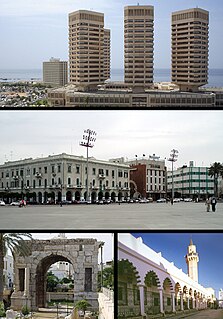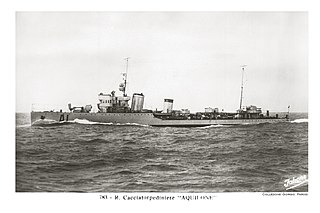
Libya, officially the State of Libya, is a country in the Maghreb region in North Africa bordered by the Mediterranean Sea to the north, Egypt to the east, Sudan to the southeast, Chad to the south, Niger to the southwest, Algeria to the west and Tunisia to the northwest. The sovereign state is made of three historical regions: Tripolitania, Fezzan and Cyrenaica. With an area of almost 700,000 square miles, Libya is the fourth largest country in Africa and is the 16th largest country in the world. Libya has the 10th-largest proven oil reserves of any country in the world. The largest city and capital, Tripoli, is located in western Libya and contains over three million of Libya's seven million people.

Tripoli is the capital and largest city of Libya, with a population of about three million people in 2019. It is located in the northwest of Libya on the edge of the desert, on a point of rocky land projecting into the Mediterranean Sea and forming a bay. It includes the port of Tripoli and the country's largest commercial and manufacturing center. It is also the site of the University of Tripoli. The vast Bab al-Azizia barracks, which includes the former family estate of Muammar Gaddafi, is also located in the city. Colonel Gaddafi largely ruled the country from his residence in this barracks.

Benghazi is a city in Libya. Located on the Gulf of Sidra in the Mediterranean, Benghazi is a major seaport and the second-most populous city in the country, as well as the largest city in Cyrenaica, with an estimated population of 632,937 in 2019.

Misrata is a city in the Misrata District in northwestern Libya, situated 187 km (116 mi) to the east of Tripoli and 825 km (513 mi) west of Benghazi on the Mediterranean coast near Cape Misrata. With a population of about 881,000, it is the third-largest city in Libya, after Tripoli and Benghazi. It is the capital city of the Misrata District and has been called the trade capital of Libya. The harbor is at Qasr Ahmad.

March 28 Stadium is a multi-purpose stadium in Benghazi, Libya, also known as Sports City Stadium. It is a part of Benghazi Sports City, used mostly for football matches and also has athletics facilities. The stadium holds 65,000 spectators. It is sometimes used by the Libya national football team, although it is not as popular as the Tripoli Stadium.

Benina International Airport serves Benghazi, Libya. It is located in the borough of Benina, 19 kilometres (12 mi) east of Benghazi, from which it takes its name. The airport is operated by the Civil Aviation and Meteorology Bureau of Libya and is the second largest in the country after Tripoli International Airport. Benina International is also the secondary hub of both Buraq Air and flag carrier, Libyan Airlines. As of 17 July 2014 all flights to the airport were suspended due to fighting in the area.

Sirte, also spelled Sirt, Surt, Sert or Syrte, is a city in Libya. It is located south of the Gulf of Sirte, between Tripoli and Benghazi. It is famously known for its battles, ethnic groups, and loyalty to Muammar Gaddafi. Also due to its development, it was the capital of Libya as Tripoli's successor after the Fall of Tripoli from 1 September 2011 to 20 October 2011. The settlement was established in the early 20th century by the Italians, at the site of a 19th-century fortress built by the Ottomans. It grew into a city after World War II.

Qasr Libya or Theodoureas is a small town in northern Libya about 66 kilometres (41 mi) northwest of Bayda. In ancient times, it was called Olbia and Theodorias, the ruins of which were excavated in the 1950s. The town contains a museum with fifty Byzantine mosaics. It's on the cross-roads between the eastwards Marj–Bayda main road, and the southwards Qasr Libya–Marawa road.
There have been no operational railways in Libya since 1965, but various lines existed in the past. An extensive system is now being developed and is under construction.
A health care crisis currently exists in Libya due to the ongoing conflict.

Ajdabiya is a town in and capital of the Al Wahat District in northeastern Libya. It is some 150 kilometres (93 mi) south of Benghazi. From 2001 to 2007 it was part of and capital of the Ajdabiya District. The town is divided into three Basic People's Congresses: North Ajdabiya, West Ajdabiya and East Ajdabiya.

The First Libyan Civil War was an armed conflict in 2011 in the North African country of Libya which was fought between forces which were loyal to Colonel Muammar Gaddafi and foreign supported groups which were seeking to oust his government. It erupted with the Libyan Revolution, also known as the 17 February Revolution. The war was preceded by protests in Zawiya on 8 August 2009 and finally ignited by protests in Benghazi beginning on Tuesday, 15 February 2011, which led to clashes with security forces that fired on the crowd. The protests escalated into a rebellion that spread across the country, with the forces opposing Gaddafi establishing an interim governing body, the National Transitional Council.

The 2011 Tripoli clashes were a series of confrontations between Libyan anti-government demonstrators and forces loyal to Libyan leader Muammar Gaddafi in the capital city of Tripoli at the beginning of the Libyan Civil War. During the early days of the uprising, there was significant unrest in the city, but the city remained under the control of the government.

Uzu Hotel or Ozoo or Ouzou Hotel is a hotel in Benghazi, Libya, overlooking the 23 July Lake of the inner harbour. It contains 184 rooms and is served by the Jasmine Cafe. The hotel was once nearly destroyed by a missile.

The Second Battle of Benghazi was a battle in the Libyan Civil War between army units and militiamen loyal to Libyan leader Muammar Gaddafi, and anti-Gaddafi forces in Benghazi. The battle marked the start of a United Nations-mandated military intervention in the conflict, with fighter jets from the French Air Force attacking and destroying several pro-Gaddafi units, forcing them to retreat.

The 2012 Benghazi attack was a coordinated attack against two United States government facilities in Benghazi, Libya, by members of the Islamic militant group Ansar al-Sharia.

Four Americans died in the 2012 Benghazi attack: Ambassador Chris Stevens, Information Officer Sean Smith, and two CIA operatives, Glen Doherty and Tyrone Woods, both former Navy SEALs. Stevens is the first U.S. ambassador killed in an attack since Adolph Dubs was killed in 1979. Senior intelligence officials later acknowledged that Woods and Doherty were contracted by the Central Intelligence Agency, not the State Department as previously identified, and were part of Global Response Staff (GRS), a team that provides security to CIA case officers and countersurveillance and surveillance protection.

The Battle of Benghazi (2014–2017) was a major battle of the Second Libyan Civil War that raged from October 2014 to December 2017, between the Shura Council of Benghazi Revolutionaries, Islamic State of Iraq and the Levant in Libya, and the Libyan National Army", and paramilitaries supporting the Libyan National Army in the city. The battle was a direct consequence of the failed Benina Airport Offensive by the Benghazi Revolutionaries and their Allies, which allowed LNA Forces to regroup and attack deep into Benghazi.
The following is a timeline of the history of the city of Benghazi, Libya.

Aquilone was one of eight Turbine-class destroyers built for the Regia Marina during the late 1920s. She was named after Aquilone, a cold northerly wind.


















